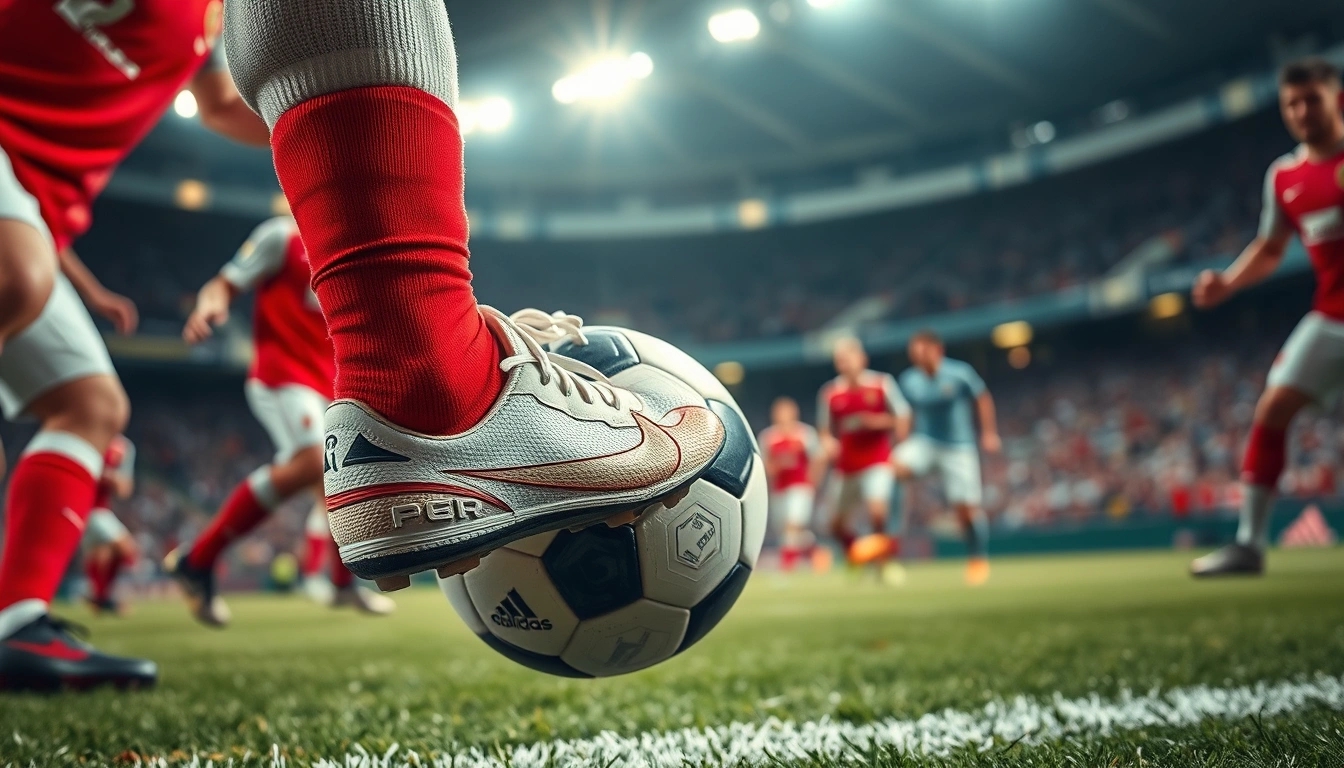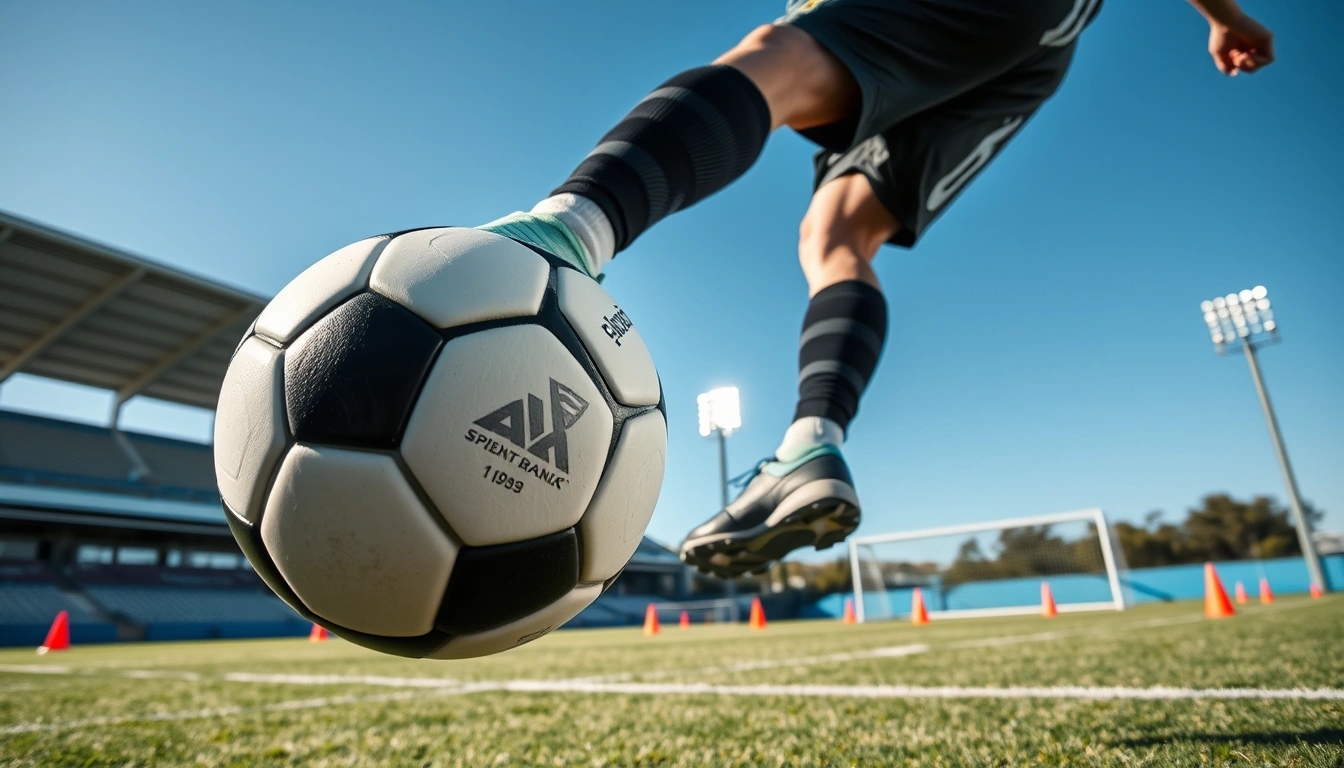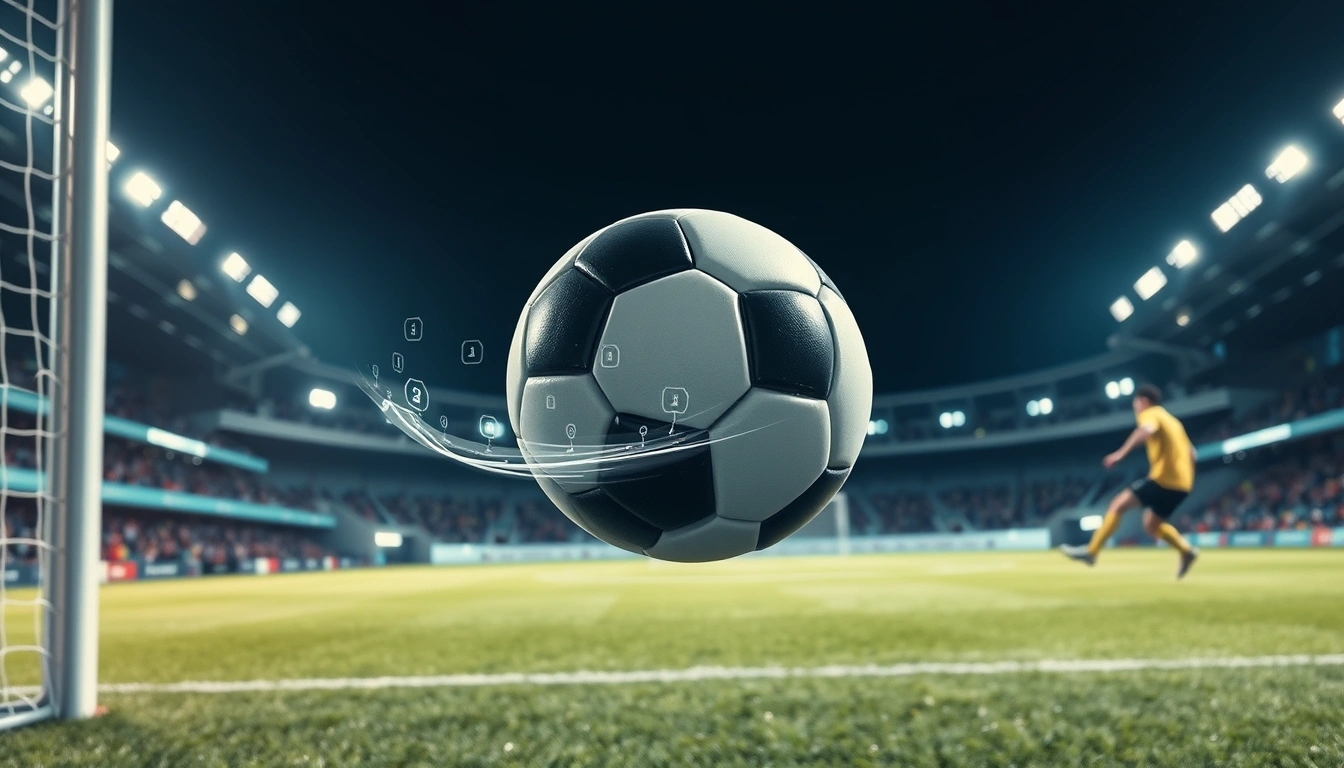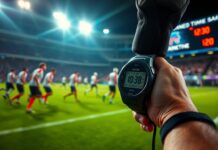Alright, let’s get real about free kicks — specifically, why some players just seem to have that magic touch, curling the ball like it’s got a mind of its own. It’s not just luck or some mystical soccer sorcery. There’s a whole blend of art and science behind those jaw-dropping, bending shots that leave goalkeepers scratching their heads and fans jumping out of their seats.
First off, curling the ball is about control and precision. You’re not just blasting it straight and hoping for the best. Nope, the ball’s gotta spin, dip, and swerve in mid-air, teasing defenders and goalies alike. This isn’t some random flick of the foot — it’s a calculated strike that requires understanding physics, body mechanics, and even a bit of psychology.
| Key Factors in Curling the Ball | Description |
|---|---|
| Foot Placement | Striking the ball off-center to generate spin |
| Body Posture | Leaning and follow-through to control trajectory |
| Ball Spin | Magnus effect causing the ball to curve |
| Psychological Tactics | Deception and timing to outwit the goalkeeper |
Now, physics nerds will love this — it’s all about the Magnus effect. When a player kicks the ball with spin, air pressure differences around the ball cause it to curve. Think of it like a tennis serve with some wicked topspin, or a baseball pitcher throwing a curveball. It’s science meeting sport head-on. But don’t get me wrong, knowing the science is one thing; pulling it off under pressure is a whole other beast.
And speaking of pressure, you gotta consider the mental game. Free kick specialists aren’t just muscle and technique; they’re also masters of mind games. They’ll glance one way, then strike another, messing with the goalkeeper’s head. Confidence here is key — if you doubt yourself, the ball’s gonna fly way off target, trust me.
- Deception: Faking a shot to the near post, then curling it to the far corner.
- Timing: Striking the ball just as the wall jumps or shifts.
- Routine: Having a consistent run-up that lulls opponents into a false sense of security.
But hey, nobody’s perfect. Even the best curlers mess up — sometimes the ball goes too wide, sometimes it’s too flat, and sometimes, well, it just flops. Common mistakes include striking the ball too hard without enough spin or misjudging the angle, which can send the ball sailing over the bar or into the wall.
Here’s a quick cheat sheet for aspiring curlers:
1. Approach the ball at a slight angle.2. Plant your non-kicking foot beside the ball.3. Strike the ball off-center with the inside of your foot.4. Follow through in the direction you want the ball to curl.5. Keep your head down and eyes on the ball.6. Practice, practice, practice — under pressure if you can!
And let’s not forget the ball itself — yep, the type and air pressure can make a surprising difference. A slightly under-inflated ball might curl more easily, but too soft and it loses speed. The latest tech balls are designed for consistent flight, but they also demand precise technique.
So, next time you see a free kick bend like a rainbow into the net, remember: it’s a beautiful cocktail of physics, skill, and a sprinkle of mind games. Not every player can do it, and that’s what makes free kick specialists so darn special on the pitch.
The Physics Behind the Curl
Alright, let’s get one thing straight: curling a football isn’t just some magic trick pulled out of thin air. There’s a whole lot of science, physics, and a pinch of wizardry behind that beautiful curve that leaves goalkeepers scratching their heads and defenders biting their nails. At the heart of this spectacle lies the Magnus effect, a phenomenon that’s as fascinating as it is frustrating for anyone standing between the ball and the net.
So, what exactly is this Magnus effect? Simply put, when a ball spins through the air, it creates a difference in air pressure on either side of it. This pressure difference causes the ball to move sideways, curving away from a straight path. Imagine the ball as a tiny planet spinning and pushing air around it, creating a force that bends its flight. Sounds simple, but the devil’s in the details—speed, spin rate, air density, and even the ball’s surface texture all play their part.
| Factor | Effect on Curl |
|---|---|
| Spin Rate | Higher spin stronger curve |
| Ball Speed | Too fast reduces curve; moderate speed ideal |
| Air Density | Denser air enhances Magnus effect |
| Surface Texture | Rougher surface increases air friction, aiding curl |
Now, here’s where things get a bit funky. You’d think the ball just spins and magically bends, but it’s actually a tug-of-war between aerodynamic forces. The spinning ball drags air around with it, causing the air on one side to move faster than the other. Faster airflow means lower pressure, and nature being nature, the ball moves towards the low-pressure side. This sideways force is what makes the ball swerve mid-air.
- Topspin makes the ball dip quicker.
- Backspin can make it float or slow down.
- Side spin causes the classic left or right curve.
Interestingly, the Magnus effect isn’t just a football thing. Tennis players, baseball pitchers, and even cricket bowlers exploit it to bamboozle their opponents. But in football, the stakes feel higher—because that curve can mean the difference between glory and heartbreak.
Practical Insight:- To maximize curl, players strike the ball off-center, imparting side spin.- The foot’s angle and follow-through determine spin direction and intensity.- Environmental factors like wind can either help or hinder the ball’s flight.
So next time you marvel at a bending free kick, remember it’s not just skill—it’s science in motion, a dance between physics and flair that keeps the game endlessly thrilling.
Historical Legends of the Curled Free Kick
Ah, the art of curling a free kick — it’s not just about kicking a ball; it’s about sending a little piece of magic flying through the air, teasing goalkeepers and defenders alike. When you think about the legends who mastered this craft, names pop up that make any football fan’s heart skip a beat. These players didn’t just bend the ball; they bent the rules of physics and expectations, setting standards that still inspire budding curlers today.
Let’s kick things off with Roberto Carlos. The Brazilian left-back wasn’t your typical free kick specialist, but his infamous thunderbolt against France in 1997 still echoes in football folklore. That shot wasn’t just curved; it was practically a missile with a mind of its own. You’d swear the ball was defying gravity, leaving everyone dumbfounded. Carlos showed us that power and curl could coexist — a lesson many have tried to replicate but few have nailed.
| Player | Nationality | Signature Free Kick Style | Notable Moment |
|---|---|---|---|
| Roberto Carlos | Brazil | Powerful curl with extreme swerve | 1997 vs France (The Banana Shot) |
| David Beckham | England | Elegant, precise curling free kicks | 1996 vs Greece (World Cup Qualifier) |
| Juninho Pernambucano | Brazil | Deadly accuracy and dip | Multiple Ligue 1 free kicks |
| Michel Platini | France | Graceful curl with tactical placement | Euro 1984 free kicks |
Then there’s David Beckham, the poster boy for bending it like… well, Beckham. His free kicks were less about brute force and more about finesse and pinpoint accuracy. Remember that 1996 World Cup qualifier against Greece? The ball curled so perfectly around the wall it looked like it had a GPS guiding it. Beckham’s style was all about subtlety, the kind of curl that whispers rather than shouts.
Oh, and how can we forget Juninho Pernambucano? The man was basically a free kick wizard. With a technique so refined, he could curl the ball into the net from distances that made you question if he had a cheat code. His shots had this beautiful dip and swerve combo that left goalkeepers grasping at thin air. Juninho’s legacy is so strong that many modern players still study his style frame-by-frame.
- Michel Platini – The graceful French maestro who combined tactical intelligence with curling mastery.
- Sinisa Mihajlovic – Known for his powerful, knuckleball-like free kicks that still had a hint of curl.
- Andrea Pirlo – The calm assassin, whose curling free kicks were as much about disguise as precision.
Here’s a quick rundown of what made these legends stand out beyond just the curl itself:
- Unique striking techniques that suited their style and physique- Mental toughness to handle pressure moments- Innovative training routines focusing on spin and placement- Ability to read the goalkeeper’s positioning and exploit it
So next time you see a free kick curling beautifully into the top corner, remember, it’s not just luck. It’s a craft honed by decades of legends who dared to challenge the laws of physics — and goalkeepers’ patience. They didn’t just set standards; they inspired generations to pick up the ball and try their luck at bending reality on the pitch.
In the end, curling a free kick isn’t just a skill — it’s a legacy.

Technique: How to Curl the Ball Perfectly
Alright, let’s get into the nitty-gritty of what makes free kick specialists send that ball on a magical, bending rollercoaster ride that leaves goalkeepers scratching their heads. It’s not just about kicking hard and hoping for the best — there’s a whole science and art combo going on here. Foot placement, strike angle, and body posture are the holy trinity that every curler swears by, although nailing them perfectly? Easier said than done.
First off, foot placement is where it all begins. You don’t just plant your foot anywhere; the non-kicking foot needs to be positioned just beside the ball, roughly 6-12 cm away, pointing in the direction you want the ball to start its journey. Too close or too far, and you risk losing control or power. It’s like setting the foundation of a house — shaky footing, shaky shot. The angle of this foot also subtly influences the ball’s trajectory. A slight tilt inward or outward can change the curve’s direction.
| Aspect | Key Points | Common Mistakes |
|---|---|---|
| Foot Placement | Non-kicking foot beside ball, pointing target direction | Too far or too close, foot pointing wrong way |
| Strike Angle | Inside of foot contacts ball, striking slightly off-center | Hitting dead center, or using toe (no good!) |
| Body Posture | Leaning slightly over ball, hips rotated | Leaning back too much, causing ballooning shots |
Now, the strike angle is where the magic really happens. To get that wicked curve, players usually hit the ball with the inside of their foot, brushing it on one side rather than smack dab in the middle. This imparts spin — the secret sauce behind the ball’s swerve. The contact point is critical: too central and the ball flies straight, no curve; too far to the side and you risk slicing the shot off target. And please, avoid the toe! It’s tempting for power, but curling? Forget it.
Body posture might sound like something yoga instructors harp on, but it’s crucial here. Leaning slightly over the ball helps keep the shot low and controlled, while a subtle hip rotation sets up the direction of the curve. If you lean back, you’re basically inviting the ball to skyrocket over the wall and out of play. You want that balance between power and finesse — and yes, it takes hours of practice to get it right.
- Tip 1: Practice striking the ball at different points with the inside of your foot to feel how the spin changes.
- Tip 2: Use cones or markers to simulate the wall and practice bending the ball around them.
- Tip 3: Film yourself to spot flaws in foot placement and posture — sometimes you don’t realize you’re leaning too far back!
In the end, curling the ball perfectly is a blend of muscle memory, feel, and a pinch of luck. Even the best in the world miss sometimes — that’s just part of the beautiful game. But get these basics down, and you’re well on your way to making defenders and keepers look silly with your wicked bends.
Remember: It’s not just about raw power, it’s about finesse, precision, and knowing exactly how to manipulate the ball’s flight. So go out there, kick some balls, and maybe one day you’ll have that signature curl that makes fans jump out of their seats.
The Role of Ball Type and Air Pressure
When it comes to curling a free kick, most folks immediately think about the player’s skill, the angle, or the spin. But here’s a little secret that often gets overlooked: the ball itself and how it’s inflated can seriously make or break that magical curve. Yeah, you heard me right — not all balls are created equal, and air pressure? It’s a sneaky game-changer.
First off, let’s talk about the ball type. Modern footballs come in various designs and materials, and each one behaves differently when you strike it. For instance, a ball with a smoother surface might glide more easily through the air, but it could also be less responsive to the spin you put on it. On the flip side, a ball with textured panels can grip the air better, enhancing the Magnus effect — that physics wizardry that makes the ball bend like a pro’s dream shot.
| Ball Type | Surface Texture | Effect on Curl |
|---|---|---|
| Traditional Leather | Smooth | Less air resistance, less pronounced curl |
| Modern Synthetic | Textured | Better grip on air, sharper curve |
| Futsal Ball | Soft, matte finish | Less bounce, moderate curl |
Now, onto the air pressure — this is where things get a bit tricky. Inflate the ball too much, and it becomes rock hard, making it difficult to control the spin. Too little air, and the ball feels like a deflated pumpkin, sluggish and unpredictable. The sweet spot? Usually, it’s just below the maximum recommended pressure. This allows the ball to maintain its shape while still being pliable enough to respond to the player’s touch.
- High pressure: Ball travels faster but with less curl.
- Low pressure: Ball can dip and swerve more but might lose speed.
- Optimal pressure: Balanced speed and curl, ideal for free kicks.
Think of it like tuning a guitar string — too tight, it snaps; too loose, it sounds off-key. The ball’s inflation needs that Goldilocks zone to sing the perfect curling tune.
Here’s a quick rundown of how air pressure affects the ball’s behavior during a curled free kick:
Pressure Level | Ball Hardness | Spin Control | Curl Potential | Shot Speed-------------------|---------------|--------------|----------------|-----------Maximum Allowed | Very Hard | Low | Minimal | Very HighRecommended Range | Firm | Moderate | Good | BalancedBelow Recommended | Soft | High | High | Lower
So next time you see a free kick specialist bending it like Beckham, remember there’s a whole lot more than just foot skills at play. The ball’s make-up and how it’s pumped up can either be the unsung hero or the silent saboteur of that beautiful curve. It’s a subtle art, really — and those who master it? They’re not just players; they’re ball whisperers.
In the end, it’s a mix of science, feel, and a bit of trial and error. Because no matter how perfect your technique is, if the ball’s not cooperating, you’re just kicking air. Literally.
Goalkeepers vs. Curlers: The Eternal Battle
Ah, the dreaded curling shot — the bane of every goalkeeper’s existence. If you think standing between the posts is all about reflexes and diving skills, think again. Those wickedly bending balls can turn even the best shot-stoppers into nervous wrecks. Why? Because curling shots are unpredictable, sneaky, and downright frustrating. It’s like trying to catch smoke with your bare hands.
The main reason goalies hate curling shots is simple: the ball doesn’t go where you expect it to. Thanks to the Magnus effect, the spinning ball curves mid-air, making it difficult to judge its path. Imagine you’re lining up for a save, and suddenly the ball veers off at an unexpected angle. Panic sets in. You leap one way, but the ball’s already slipped past your fingertips on the other side. Ouch.
| Challenges Goalkeepers Face | Training Strategies |
|---|---|
| Unpredictable ball trajectory | Studying player habits and shot patterns |
| Late curve changes in flight | Reaction drills with spinning balls |
| Pressure of split-second decision-making | Simulated game scenarios under stress |
But it’s not all doom and gloom for the keepers. They’re not just standing there hoping for the best. In fact, many spend hours analyzing the “curlers” — those free kick wizards who can send the ball bending around walls and into the top corner. Goalkeepers watch footage obsessively, trying to pick up on subtle tells: the angle of the approach, the foot placement, even the way the kicker’s hips twist. All these little clues help anticipate the ball’s flight.
- Anticipation drills: Goalkeepers practice reading the ball’s spin and trajectory early.
- Reflex training: Quick reaction exercises to improve response times.
- Positioning: Learning to position themselves optimally to cover the most likely shot paths.
It’s a constant cat-and-mouse game. Curlers refine their techniques to add more spin, dip, and swerve, while goalies evolve their skills to predict and counter these moves. Sometimes, it feels like goalkeepers are just gambling — guessing where the ball *might* go based on tiny hints.
Practical Tip: One common training drill involves goalkeepers facing shots from curl specialists at varying distances. The kicker changes the spin and speed randomly, forcing the goalie to rely on instinct and quick judgment rather than pre-planned moves. It’s messy, unpredictable, and exactly what prepares them for real-game chaos.
So, the next time you see a goalkeeper flailing wildly or diving the wrong way after a curling free kick, cut them some slack. They’re battling physics, psychology, and pure guesswork all at once. It’s an eternal struggle — one that makes football all the more thrilling to watch.
Summary Table: Key Takeaways
| Aspect | Why It Matters | Goalkeeper Strategy |
|---|---|---|
| Unpredictable Spin | Changes ball trajectory mid-flight | Focus on early detection of spin |
| Player Habits | Patterns reveal shot tendencies | Video analysis and scouting |
| Pressure Moments | High stakes increase errors | Simulated high-pressure drills |
In the end, curling shots and goalkeepers are locked in a timeless duel — a chess match played at 100 miles per hour with a leather ball. And honestly? That’s what makes the game beautiful, maddening, and utterly addictive.

Training Drills for Aspiring Curl Specialists
Alright, so you wanna curl the ball like those free kick maestros who make goalkeepers look like they’re chasing ghosts? Well, it ain’t just about kicking the ball and hoping for the best. There’s a whole bunch of drills and routines that players swear by to get that signature bend and nail accuracy, especially when the pressure’s on. Let’s dive into some of the most practical exercises that can turn any hopeful into a curling wizard.
1. The Basic Curl Strike Drill
This one’s the bread and butter. Set up a wall of cones about 8-10 yards away, mimicking a defensive wall. The goal? Kick the ball over or around the cones, aiming for a target zone behind them. Focus on foot placement — the inside of your foot brushing the ball’s side, with a bit of a lean to generate spin. Repeat this 20-30 times, trying to get consistent curl and height.
| Drill | Purpose | Reps | Focus Points |
|---|---|---|---|
| Basic Curl Strike | Build spin and accuracy | 20-30 | Foot placement, ball contact, follow-through |
| Pressure Simulation | Accuracy under stress | 15-20 | Speed, composure, target hitting |
| Target Practice | Precision and placement | 25-30 | Focus on hitting corners |
2. Pressure Simulation
Nothing like a bit of stress to test your curling skills. Have a teammate or coach call out random targets or add a time limit before you strike. This drill forces you to keep calm and deliver the curl accurately even when your heart’s pounding. Because let’s be honest, in a real game, you don’t have the luxury of taking forever.
3. Target Practice with Varied Distances
Curling the ball from 20 yards is different from 30 yards, right? So mix it up. Place targets at different distances and heights within the goal area. Try to bend the ball around imaginary walls and hit those spots consistently. This helps develop muscle memory for different free kick scenarios.
- Tip: Use markers or small nets as targets for visual feedback.
- Tip: Record your kicks to analyze trajectory and spin later.
- Tip: Vary ball pressure to feel the difference in curl behavior.
Now, here’s a little secret: repetition is king, but so is variety. If you keep doing the same drill over and over, your brain and muscles get lazy. Mix up the drills, change your approach angle, and even try curling with your weaker foot to build versatility.
Sample Weekly Curling Routine:- Monday: Basic Curl Strike (30 reps)- Wednesday: Pressure Simulation (20 reps)- Friday: Target Practice (30 reps)- Sunday: Light practice + video review
Also, don’t neglect fitness and flexibility. A stiff ankle or tight hips can kill your curl. Stretch, strengthen, and keep that kicking leg loose.
In the end, curling a free kick isn’t just about technique—it’s about confidence, patience, and a bit of stubbornness. So next time you’re on the pitch, remember: those bending beauties come from hours of sweat, a few missed shots, and a whole lot of determination. Now, get out there and curl that ball like you mean it!
Psychological Edge: Mind Games in Free Kicks
Alright, let’s get real for a moment. When you watch a free kick specialist line up for that crucial shot, it’s not just about the fancy footwork or the perfect curl on the ball. No, sir. There’s a whole other game happening in the player’s head and, believe it or not, in the goalkeeper’s too. Confidence, deception, and timing—these aren’t just buzzwords; they’re the secret sauce that can turn a decent free kick into a legendary one.
First off, confidence. Ever noticed how some players just look like they own the moment? They don’t hesitate, they don’t second guess. That swagger alone can rattle defenders and the goalie. It’s like they’re saying, “Yeah, I’m about to do something special, and you can’t stop me.” This mental edge often forces the keeper to commit early or guess wrong. But here’s the kicker—confidence isn’t just some natural-born trait. It’s built through practice, repetition, and sometimes sheer stubbornness. A player who trusts their curl, their strike, and their ability to read the wall is already halfway to scoring.
| Psychological Factor | Impact on Free Kick |
|---|---|
| Confidence | Forces goalkeepers to second guess, reduces hesitation |
| Deception | Misleads defenders and goalie on shot direction |
| Timing | Disrupts goalkeeper’s anticipation and reaction |
Now, deception—oh boy, this one’s a crafty beast. Players often use body language, eye movement, or even the angle of their approach to trick opponents. Think about it: a slight glance to the left, a subtle shift in weight, or a fake run-up can send defenders the wrong way. And when the goalie bites on the fake? Bam! The ball curls sweetly into the net’s top corner. It’s almost like a magician’s sleight of hand, but with a football. The best free kick takers are masters at blending physical technique with psychological trickery.
- Body Language: Using posture to hint a shot direction
- Eye Contact: Looking away from intended target to mislead
- Run-up Variations: Changing steps or speed to confuse defenders
Timing is another sneaky player in this mental chess game. The moment a player decides to strike can throw off the goalkeeper’s rhythm. Sometimes, a split-second pause before kicking can send the goalie lunging too early or freezing in indecision. Other times, a lightning-fast shot with no warning catches everyone off guard. It’s a delicate balance: too slow, and defenders adjust; too fast, and you risk messing up your technique.
Tips for Perfect Timing:- Observe goalkeeper’s stance and movement- Use a small hesitation to disrupt rhythm- Practice varying your run-up speed- Stay relaxed to avoid rushed shots
In the end, curling a free kick isn’t just about bending the ball—it’s about bending minds. The specialists who can mix physical skill with psychological warfare are the ones who leave fans gasping and goalkeepers shaking their heads. So next time you see a free kick curled beautifully into the net, remember: it’s as much a mental battle as it is a physical feat.
Common Mistakes and How to Avoid Them
Common Mistakes and How to Avoid Them When Curling the Ball
Curling the ball during a free kick is an art, but let’s be honest — it’s also a bit of a nightmare for many players. You think you’ve got the technique down, then *bam*, the ball either flies wildly off course or just plops straight ahead like a lame duck. So, what are the most frequent blunders that trip up curlers, and how can you fix them? Let’s dive into the mess and make sense of it all.
1. Poor Foot Placement
One of the biggest culprits behind a failed curl is where your foot lands. If your plant foot is too far from the ball or pointed in the wrong direction, you’re basically asking for a shot that’s either too straight or wildly off-target. The ideal spot? Just beside the ball, pointing slightly toward your target, giving you the leverage to wrap your foot around the ball.
- Tip: Practice placing your plant foot about 6-8 inches from the ball, angled toward your intended curve.
- Tip: Keep your foot firm and steady; wobbly footing leads to inconsistent spins.
2. Incorrect Strike Angle
If you smack the ball dead center or with the wrong part of your foot, the ball won’t curl — it’ll just rocket forward like a bullet. The sweet spot? The side of your foot, near the inside edge, brushing the ball to generate spin.
| Common Strike Errors | Effect on Ball | Fix |
|---|---|---|
| Hitting center of ball | Ball flies straight, no curl | Strike side to create spin |
| Using toe or laces | Unpredictable trajectory | Use inside edge of foot |
| Too much power, no control | Ball overshoots or loses curve | Balance power with technique |
3. Neglecting Body Posture
Ever seen someone leaning back while curling? Spoiler alert: the ball usually soars over the bar. Leaning too far forward or backward disrupts the shot’s balance and trajectory.
- Tip: Keep your upper body slightly leaning over the ball to keep the shot low and controlled.
- Tip: Your head should be steady, eyes locked on the ball until the strike.
4. Forgetting the Follow-Through
A weak or abrupt follow-through kills the spin you worked hard to generate. The foot needs to continue its natural curved motion after contact to keep that ball bending.
Correct Follow-Through: - Foot swings around the ball’s side - Body rotates naturally with the shot - Maintains momentum for spin
5. Ignoring Environmental Factors
Wind, ball condition, and pitch surface can all mess with your curl. Trying the same technique regardless of these factors is a rookie move.
| Factor | Effect | Adjustment |
|---|---|---|
| Wind | Can push ball off curve | Compensate aim upwind |
| Wet ball | Less grip, less spin | Strike cleaner and harder |
| Uneven pitch | Ball bounces unpredictably | Focus on flight over roll |
Final Thoughts
Curling the ball isn’t just about fancy flicks; it’s a blend of science, muscle memory, and a pinch of luck. Avoid these common pitfalls by focusing on fundamental technique and adapting to conditions. Remember, even the best curlers bomb shots sometimes — don’t sweat it, just keep practicing and tweaking.
Stay patient, stay curious, and maybe one day you’ll have goalkeepers shaking in their boots every time you step up for a free kick.

Future Trends: Technology and Curling Free Kicks
Alright, let’s dive into the wild world of tech and how it’s shaking up the way players curl those cheeky free kicks. You might think curling a ball is all about fancy footwork and a sprinkle of magic, but trust me, the future’s got some pretty cool gadgets and gizmos that could totally change the game.
First off, ball tracking technology is becoming a total game-changer. Imagine this: sensors embedded in the ball or high-speed cameras around the stadium capturing every spin, dip, and dip of that free kick in real-time. Coaches and players get instant feedback on how the ball’s curving, how fast it’s spinning, and whether it’s bending just right to fool the keeper. No more guessing games! This tech means training sessions can be super precise. Players can tweak their strike angle or foot placement based on solid data, not just gut feeling.
| Technology | How It Helps Curl Specialists |
|---|---|
| Ball Tracking Sensors | Measures spin rate, trajectory, and speed for detailed feedback |
| AI Coaching Tools | Analyzes player technique and suggests personalized improvements |
| Virtual Reality (VR) Training | Simulates game scenarios to practice curling under pressure |
Now, speaking of AI coaching, this is where things get a bit sci-fi. Artificial intelligence isn’t just about robots taking over the world—it’s helping players understand their own style better. AI systems can analyze hours of free kick attempts, spotting patterns and flaws that even the sharpest human eye might miss. For example, if a player tends to over-rotate their ankle or misalign their hips just a tad, AI can flag that and suggest drills to fix it.
- Personalized feedback: No more one-size-fits-all advice.
- Real-time corrections: Players get instant tips during practice.
- Mental prep: AI can simulate goalkeeper reactions, helping players sharpen their decision-making.
But hey, don’t get me wrong—tech isn’t a magic wand. Curling a free kick still needs that human touch, the flair, the unpredictability that makes football so damn exciting. What tech can do is take the guesswork out of training and help players push their limits. It’s like having a personal coach who never sleeps and never gets tired of watching you practice the same shot over and over.
One thing to watch out for? The risk of over-reliance on data. If players start obsessing over every tiny detail, they might lose that instinctive feel for the ball. So, balance is key—use tech as a tool, not a crutch.
Practical Tips for Using Tech in Curling Free Kick Training:1. Combine video analysis with ball tracking to see both technique and ball behavior.2. Use AI feedback to create customized drills targeting your weak spots.3. Practice with VR setups to simulate crowd noise and goalkeeper pressure.4. Review data post-training, but always trust your gut during the game.
In summary, the future of curling free kicks is looking pretty slick with all these tech advancements. Ball tracking and AI coaching won’t replace the artistry of a well-placed curl but will definitely help players sharpen their skills faster and smarter. So next time you see a jaw-dropping free kick bend around the wall, remember—it might just be a little help from some high-tech friends behind the scenes.
Stay tuned, because the beautiful game is only getting more beautiful with tech on its side!
Frequently Asked Questions
- What exactly causes the ball to curl during a free kick?
Great question! It’s all about the Magnus effect. When a player strikes the ball with a spin, air pressure differences around the ball create a force that makes it curve mid-air. Think of it like a spinning top that wobbles and turns — the ball’s spin tricks defenders and goalkeepers by bending its path unexpectedly.
- How do free kick specialists perfect their curling technique?
It’s a mix of foot placement, strike angle, and body posture. Players usually hit the ball off-center with the inside or outside of their foot, combined with a leaning body to add that magical spin. It’s like painting a masterpiece but with your foot — precision and practice are key!
- Does the type of ball or its air pressure really affect the curl?
Absolutely! The ball’s material and how inflated it is can change how much it spins and moves through the air. A slightly softer or less inflated ball can grip the air better, enhancing the curve. So, even the ball’s personality plays a role in the free kick drama.
- Why do goalkeepers find curling free kicks so challenging to save?
Curling shots are like unpredictable storms for goalies. The ball’s sudden bends make it hard to judge where it’ll end up. Plus, the speed and spin can fool their eyes, forcing them to rely on quick reflexes and anticipation — it’s a mental and physical chess game on the field.
- Can anyone learn to curl the ball, or is it just for pros?
Anyone can learn with dedication! While pros have honed their skills over years, beginners can start by practicing the basics of foot placement and striking. With patience and the right drills, you can develop your own signature curl and surprise your opponents.
- What are the most common mistakes when trying to curl a free kick?
Many players either strike the ball too flat or don’t generate enough spin. Others might have poor body balance, leading to weak or inaccurate curls. Avoiding these requires focused training on technique and consistency — it’s like tuning a guitar; small tweaks make a big difference.
- How is technology shaping the future of curling free kicks?
Exciting times ahead! Tools like ball tracking and AI coaching are helping players analyze and refine their kicks with pinpoint accuracy. Imagine having a virtual coach guiding your every move — that’s the future, turning every free kick into a science and art combo.













